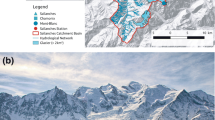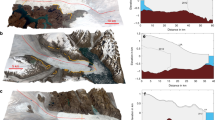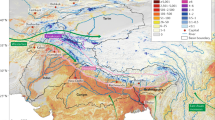Abstract
Glaciers in the high mountains of Asia (HMA) make a substantial contribution to the water supply of millions of people1,2, and they are retreating and losing mass as a result of anthropogenic climate change3 at similar rates to those seen elsewhere4,5. In the Paris Agreement of 2015, 195 nations agreed on the aspiration to limit the level of global temperature rise to 1.5 degrees Celsius ( °C) above pre-industrial levels. However, it is not known what an increase of 1.5 °C would mean for the glaciers in HMA. Here we show that a global temperature rise of 1.5 °C will lead to a warming of 2.1 ± 0.1 °C in HMA, and that 64 ± 7 per cent of the present-day ice mass stored in the HMA glaciers will remain by the end of the century. The 1.5 °C goal is extremely ambitious and is projected by only a small number of climate models of the conservative IPCC’s Representative Concentration Pathway (RCP)2.6 ensemble. Projections for RCP4.5, RCP6.0 and RCP8.5 reveal that much of the glacier ice is likely to disappear, with projected mass losses of 49 ± 7 per cent, 51 ± 6 per cent and 64 ± 5 per cent, respectively, by the end of the century; these projections have potentially serious consequences for regional water management and mountain communities.
This is a preview of subscription content, access via your institution
Access options
Access Nature and 54 other Nature Portfolio journals
Get Nature+, our best-value online-access subscription
$29.99 / 30 days
cancel any time
Subscribe to this journal
Receive 51 print issues and online access
$199.00 per year
only $3.90 per issue
Buy this article
- Purchase on Springer Link
- Instant access to full article PDF
Prices may be subject to local taxes which are calculated during checkout



Similar content being viewed by others
References
Immerzeel, W. W., Van Beek, L. P. H. & Bierkens, M. F. P. Climate change will affect the Asian water towers. Science 328, 1382–1385 (2010)
Lutz, A. F., Immerzeel, W. W., Shrestha, A. B. & Bierkens, M. F. P. Consistent increase in High Asia’s runoff due to increasing glacier melt and precipitation. Nat. Clim. Chang. 4, 587–592 (2014)
Marzeion, B., Cogley, J. G., Richter, K. & Parkes, D. Attribution of global glacier mass loss to anthropogenic and natural causes. Science 345, 919–921 (2014)
Bolch, T. et al. The state and fate of Himalayan Glaciers. Science 336, 310–314 (2012)
Kääb, A., Treichler, D., Nuth, C. & Berthier, E. Contending estimates of 2003–2008 glacier mass balance over the Pamir-Karakoram-Himalaya. Cryosphere 9, 557–564 (2015)
Pepin, N. et al. Elevation-dependent warming in mountain regions of the world. Nat. Clim. Chang. 5, 424–430 (2015)
Taylor, K. E., Stouffer, R. J. & Meehl, G. A. An overview of CMIP5 and the experiment design. Bull. Am. Meteorol. Soc. 93, 485–498 (2012)
Pfeffer, W. T. et al. The Randolph Glacier Inventory: a globally complete inventory of glaciers. J. Glaciol. 60, 537–552 (2014)
Evatt, G. W. et al. Glacial melt under a porous debris layer. J. Glaciol. 61, 825–836 (2015)
Lejeune, Y., Bertrand, J., Wagnon, P. & Morin, S. A physically based model of the year-round surface energy and mass balance of debris-covered glaciers. J. Glaciol. 59, 327–344 (2013)
Vincent, C. et al. Reduced melt on debris-covered glaciers: investigations from Changri Nup Glacier, Nepal. Cryosphere 10, 1845–1858 (2016)
Reid, T. D., Carenzo, M., Pellicciotti, F. & Brock, B. W. Including debris cover effects in a distributed model of glacier ablation. J. Geophys. Res. 117, D18105 (2012)
Pellicciotti, F., Stephan, C., Miles, E., Immerzeel, W. W. & Bolch, T. Mass balance changes of the debris-covered glaciers in the Langtang Himal in Nepal between 1974 and 1999. J. Glaciol. 61, 373–386 (2015)
Östrem, G. Ice melting under a thin layer of moraine, and the existence of ice cores in moraine ridges. Geogr. Ann. 41, 228–230 (1959)
Immerzeel, W. W., Pellicciotti, F. & Bierkens, M. F. P. Rising river flows throughout the twenty-first century in two Himalayan glacierized watersheds. Nat. Geosci. 6, 742–745 (2013)
Ragettli, S. et al. Unraveling the hydrology of a Himalayan catchment through integration of high resolution in situ data and remote sensing with an advanced simulation model. Adv. Water Resour. 78, 94–111 (2015)
Linsbauer, A., Paul, F. & Haeberli, W. Modeling glacier thickness distribution and bed topography over entire mountain ranges with GlabTop: Application of a fast and robust approach. J. Geophys. Res. Earth Surf. 117, 1–17 (2012)
Frey, H. et al. Estimating the volume of glaciers in the Himalayan & Karakoram region using different methods. Cryosphere 8, 2313–2333 (2014)
Kääb, A., Berthier, E., Nuth, C., Gardelle, J. & Arnaud, Y. Contrasting patterns of early twenty-first-century glacier mass change in the Himalayas. Nature 488, 495–498 (2012)
Benn, D. I. & Lehmkuhl, F. Mass balance and equilibrium-line altitudes of glaciers in high-mountain environments. Quat. Int. 66, 15–29 (2000)
Farinotti, D. et al. Substantial glacier mass loss in the Tien Shan over the past 50 years. Nat. Geosci. 8, 716–722 (2015)
Gardner, A. S. et al. A reconciled estimate of glacier contributions to sea level rise: 2003 to 2009. Science 340, 852–857 (2013)
Shea, J. M. & Immerzeel, W. W. An assessment of basin-scale glaciological and hydrological sensitivities in the Hindu Kush - Himalaya. Ann. Glaciol. 57, 308–318 (2016)
Bliss, A., Hock, R. & Radic´, V. Global response of glacier runoff to twenty-first century climate change. J. Geophys. Res. 119, 1–14 (2014)
Mihalcea, C. et al. Spatial distribution of debris thickness and melting from remote-sensing and meteorological data, at debris-covered Baltoro glacier, Karakoram, Pakistan. Ann. Glaciol. 48, 49–57 (2008)
Rounce, D. R., Quincey, D. J. & McKinney, D. C. Debris-covered glacier energy balance model for Imja-Lhotse Shar Glacier in the Everest region of Nepal. Cryosphere 9, 2295–2310 (2015)
Rowan, A. V., Egholm, D. L., Quincey, D. J. & Glasser, N. F. Modelling the feedbacks between mass balance, ice flow and debris transport to predict the response to climate change of debris-covered glaciers in the Himalaya. Earth Planet. Sci. Lett. 430, 427–438 (2015)
Hall, D. K., Riggs, G. A. & Salomonson, V. V. Development of methods for mapping global snow cover using moderate resolution imaging spectroradiometer data. Remote Sens. Environ. 54, 127–140 (1995)
Google Earth Engine Team. Google Earth Engine: A Planetary-Scale Geo-Spatial Analysis Platform (2017)
Paul, F., Huggel, C. & Kääb, A. Combining satellite multispectral image data and a digital elevation model for mapping debris-covered glaciers. Remote Sens. Environ. 89, 510–518 (2004)
Farr, T. et al. The shuttle radar topography mission. Rev. Geophys. 45, RG2004 (2007)
Immerzeel, W. W. et al. High-resolution monitoring of Himalayan glacier dynamics using unmanned aerial vehicles. Remote Sens. Environ. 150, 93–103 (2014)
Lillesand, T ., Kiefer, R. W & Chipman, J. Remote Sensing and Image Interpretation 7th Edn (John Wiley & Sons, 2015)
Farinotti, D. et al. How accurate are estimates of glacier ice thickness? Results from ITMIX, the Ice Thickness Models Intercomparison eXperiment. Cryosphere 11, 949–970 (2017)
Weedon, G. P. et al. Data methodology applied to ERA-Interim reanalysis data. Wat. Resour. Res. 50, 7505–7514 (2014)
Immerzeel, W. W., Wanders, N., Lutz, A. F., Shea, J. M. & Bierkens, M. F. P. Reconciling high-altitude precipitation in the upper Indus basin with glacier mass balances and runoff. Hydrol. Earth Syst. Sci. 19, 4673–4687 (2015)
Dee, D. P. et al. The ERA-Interim reanalysis: configuration and performance of the data assimilation system. Q. J. R. Meteorol. Soc. 137, 553–597 (2011)
Palazzi, E., Von Hardenberg, J. & Provenzale, A. Precipitation in the Hindu-Kush Karakoram Himalaya: observations and future scenarios. J. Geophys. Res. Atmos. 118, 85–100 (2013)
Dahri, Z. H. et al. An appraisal of precipitation distribution in the high-altitude catchments of the Indus basin. Sci. Total Environ. 548–549, 289–306 (2016)
Foster, L. A., Brock, B. W., Cutler, M. E. J. & Diotri, F. A physically based method for estimating supraglacial debris thickness from thermal band remote-sensing data. J. Glaciol. 58, 677–691 (2012)
Rounce, D. R. & McKinney, D. C. Debris thickness of glaciers in the Everest Area (Nepal Himalaya) derived from satellite imagery using a nonlinear energy balance model. Cryosphere 8, 1317–1329 (2014)
Nicholson, L. & Benn, D. I. Properties of natural supraglacial debris in relation to modelling sub-debris ice ablation. Earth Surf. Process. Landf. 38, 490–501 (2013)
Juen, M., Mayer, C., Lambrecht, A., Han, H. & Liu, S. Impact of varying debris cover thickness on ablation: a case study for Koxkar Glacier in the Tien Shan. Cryosphere 8, 377–386 (2014)
Mihalcea, C. et al. Ice ablation and meteorological conditions on the debris-covered area of Baltoro glacier, Karakoram, Pakistan. Ann. Glaciol. 43, 292–300 (2006)
Kayastha, R. B., Takeuchi, Y., Nakawo, M. & Ageta, Y. Practical prediction of ice melting beneath various thickness of debris cover on Khumbu Glacier, Nepal, using a positive degree-day factor. IAHS-AISH Publication 264, 71–81 (2000)
Nicholson, L. I. & Benn, D. I. Calculating ice melt beneath a debris layer using meteorological data. J. Glaciol. 52, 463–470 (2006)
Collier, E. & Immerzeel, W. W. High-resolution modeling of atmospheric dynamics in the Nepalese Himalaya. J. Geophys. Res. Atmos. 120, 9882–9896 (2015)
Zhang, Z. et al. Mass change of glaciers in Muztag Ata – Kongur Tagh, Eastern Pamir, China from 1971/76 to 2013/14 as derived from remote sensing data. PLoS One 11, e0147327 (2016)
Yao, T. et al. Different glacier status with atmospheric circulations in Tibetan Plateau and surroundings. Nat. Clim. Chang. 2, 663–667 (2012)
Gardelle, J., Berthier, E., Arnaud, Y. & Kääb, A. Region-wide glacier mass balances over the Pamir-Karakoram-Himalaya during 1999–2011. Cryosphere 7, 1263–1286 (2013)
Ke, L., Ding, X. & Song, C. Heterogeneous changes of glaciers over the western Kunlun Mountains based on ICESat and Landsat-8 derived glacier inventory. Remote Sens. Environ. 168, 13–23 (2015)
Sorg, A., Bolch, T., Stoffel, M., Solomina, O. & Beniston, M. Climate change impacts on glaciers and runoff in Tien Shan (Central Asia). Nat. Clim. Chang. 2, 725–731 (2012)
Cogley, J. G. Geodetic and direct mass-balance measurements: comparison and joint analysis. Ann. Glaciol. 50, 96–100 (2009)
Marshall, S. J. et al. Glacier water resources on the eastern slopes of the Canadian Rocky Mountains. Can. Water Resour. J. 36, 109–134 (2011)
Scherler, D., Bookhagen, B. & Strecker, M. R. Spatially variable response of Himalayan glaciers to climate change affected by debris cover. Nat. Geosci. 4, 156–159 (2011)
Acknowledgements
This project has received funding from the European Research Council (ERC) under the European Union’s Horizon 2020 research and innovation programme (grant agreement number 676819), The Netherlands Organization for Scientific Research under the Innovational Research Incentives Scheme VIDI (grant agreement 016.181.308), from the Climate-KIC programme of the European Institute of Innovation & Technology (EIT), and from the UK Government’s Department for International Development and the International Development Research Centre, Canada, through the Himalayan Adaptation, Water and Resilience (HI-AWARE) consortium. We thank E. Berthier and D. Scherler for supplying the validation data.
Author information
Authors and Affiliations
Contributions
W.W.I., P.D.A.K. and M.F.P.B. designed the study; P.D.A.K. performed all analyses; A.F.L. contributed the climate change scenarios; P.D.A.K. and W.W.I. wrote the manuscript with suggestions from M.F.P.B. and A.F.L.
Corresponding author
Ethics declarations
Competing interests
The authors declare no competing financial interests.
Additional information
Reviewer Information Nature thanks J. G. Cogley and D. Farinotti for their contribution to the peer review of this work.
Publisher's note: Springer Nature remains neutral with regard to jurisdictional claims in published maps and institutional affiliations.
Supplementary information
Supplementary Information
This file contains Supplementary Figures 1-17 and Supplementary Tables 1-5. (PDF 3939 kb)
Supplementary Data
This file contains animated cross sections and maps of modelled ice thickness over time for each of the four RCPs for 17 different glaciers. (ZIP 44470 kb)
Rights and permissions
About this article
Cite this article
Kraaijenbrink, P., Bierkens, M., Lutz, A. et al. Impact of a global temperature rise of 1.5 degrees Celsius on Asia’s glaciers. Nature 549, 257–260 (2017). https://doi.org/10.1038/nature23878
Received:
Accepted:
Published:
Issue Date:
DOI: https://doi.org/10.1038/nature23878
This article is cited by
-
Glacier retreat and lake outburst floods in the central Himalayan region from 2000 to 2022
Natural Hazards (2024)
-
Development of Skutterudite-Type Thermoelectric Materials LaxCo4Sb12 Using High-Pressure Synthesis Method
JOM (2024)
-
Deep Learning-Based Glacial Lakes Extraction and Mapping in the Chandra–Bhaga Basin
Journal of the Indian Society of Remote Sensing (2024)
-
Multi-parametrical analysis of Haptal glacier, lower Chenab basin, Jammu and Kashmir, India: A remote sensing approach
Journal of Earth System Science (2024)
-
Four decades of Glacier and Glacial Lake dynamics in Kishtwar high altitude National Park, Chenab Basin, Jammu and Kashmir, India
Modeling Earth Systems and Environment (2024)
Comments
By submitting a comment you agree to abide by our Terms and Community Guidelines. If you find something abusive or that does not comply with our terms or guidelines please flag it as inappropriate.



